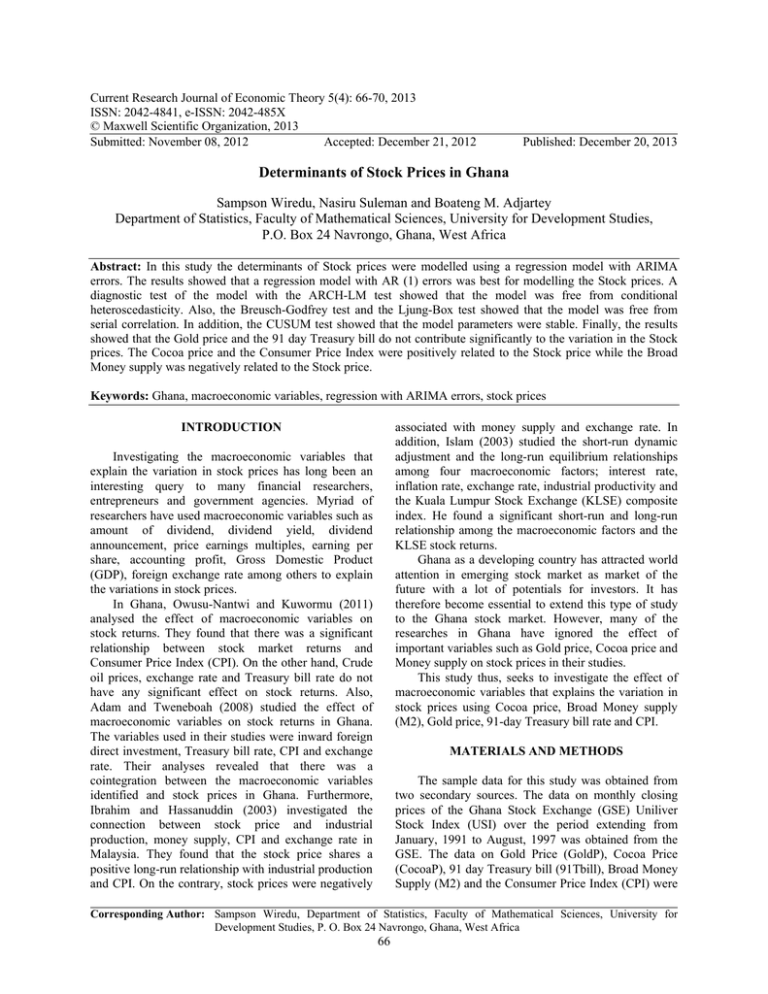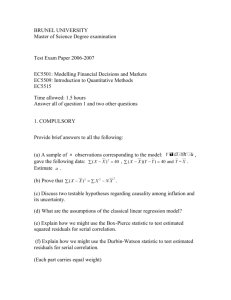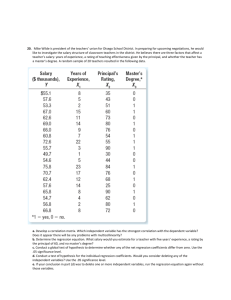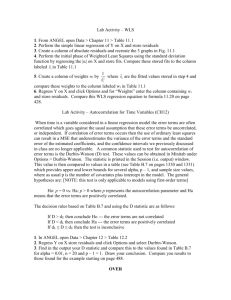Current Research Journal of Economic Theory 5(4): 66-70, 2013
advertisement

Current Research Journal of Economic Theory 5(4): 66-70, 2013 ISSN: 2042-4841, e-ISSN: 2042-485X © Maxwell Scientific Organization, 2013 Submitted: November 08, 2012 Accepted: December 21, 2012 Published: December 20, 2013 Determinants of Stock Prices in Ghana Sampson Wiredu, Nasiru Suleman and Boateng M. Adjartey Department of Statistics, Faculty of Mathematical Sciences, University for Development Studies, P.O. Box 24 Navrongo, Ghana, West Africa Abstract: In this study the determinants of Stock prices were modelled using a regression model with ARIMA errors. The results showed that a regression model with AR (1) errors was best for modelling the Stock prices. A diagnostic test of the model with the ARCH-LM test showed that the model was free from conditional heteroscedasticity. Also, the Breusch-Godfrey test and the Ljung-Box test showed that the model was free from serial correlation. In addition, the CUSUM test showed that the model parameters were stable. Finally, the results showed that the Gold price and the 91 day Treasury bill do not contribute significantly to the variation in the Stock prices. The Cocoa price and the Consumer Price Index were positively related to the Stock price while the Broad Money supply was negatively related to the Stock price. Keywords: Ghana, macroeconomic variables, regression with ARIMA errors, stock prices associated with money supply and exchange rate. In addition, Islam (2003) studied the short-run dynamic adjustment and the long-run equilibrium relationships among four macroeconomic factors; interest rate, inflation rate, exchange rate, industrial productivity and the Kuala Lumpur Stock Exchange (KLSE) composite index. He found a significant short-run and long-run relationship among the macroeconomic factors and the KLSE stock returns. Ghana as a developing country has attracted world attention in emerging stock market as market of the future with a lot of potentials for investors. It has therefore become essential to extend this type of study to the Ghana stock market. However, many of the researches in Ghana have ignored the effect of important variables such as Gold price, Cocoa price and Money supply on stock prices in their studies. This study thus, seeks to investigate the effect of macroeconomic variables that explains the variation in stock prices using Cocoa price, Broad Money supply (M2), Gold price, 91-day Treasury bill rate and CPI. INTRODUCTION Investigating the macroeconomic variables that explain the variation in stock prices has long been an interesting query to many financial researchers, entrepreneurs and government agencies. Myriad of researchers have used macroeconomic variables such as amount of dividend, dividend yield, dividend announcement, price earnings multiples, earning per share, accounting profit, Gross Domestic Product (GDP), foreign exchange rate among others to explain the variations in stock prices. In Ghana, Owusu-Nantwi and Kuwormu (2011) analysed the effect of macroeconomic variables on stock returns. They found that there was a significant relationship between stock market returns and Consumer Price Index (CPI). On the other hand, Crude oil prices, exchange rate and Treasury bill rate do not have any significant effect on stock returns. Also, Adam and Tweneboah (2008) studied the effect of macroeconomic variables on stock returns in Ghana. The variables used in their studies were inward foreign direct investment, Treasury bill rate, CPI and exchange rate. Their analyses revealed that there was a cointegration between the macroeconomic variables identified and stock prices in Ghana. Furthermore, Ibrahim and Hassanuddin (2003) investigated the connection between stock price and industrial production, money supply, CPI and exchange rate in Malaysia. They found that the stock price shares a positive long-run relationship with industrial production and CPI. On the contrary, stock prices were negatively MATERIALS AND METHODS The sample data for this study was obtained from two secondary sources. The data on monthly closing prices of the Ghana Stock Exchange (GSE) Uniliver Stock Index (USI) over the period extending from January, 1991 to August, 1997 was obtained from the GSE. The data on Gold Price (GoldP), Cocoa Price (CocoaP), 91 day Treasury bill (91Tbill), Broad Money Supply (M2) and the Consumer Price Index (CPI) were Corresponding Author: Sampson Wiredu, Department of Statistics, Faculty of Mathematical Sciences, University for Development Studies, P. O. Box 24 Navrongo, Ghana, West Africa 66 Curr. Res. J. Econ. Theory., 5(4): 66-70, 2013 obtained from the Bank of Ghana database over the same period as the Stock price. The Uniliver Stock Price (StockP) was chosen for this study because it is one of the companies that have been consistent on GSE market. B denote the lag operator Thus: Unit root test: To avoid spurious regression, this test was carried to check whether the series under consideration were stationary using the Augmented Dickey-Fuller (ADF) test. Three different tests were performed by fitting a model without constant, with constant and with constant and trend. The test is based on the assumption that a time series data follows a random walk: Model selection criteria: For the purpose of this study, three model selection criteria were employed in selecting the model. These methods are the Akaike Information Criterion (AIC), the Schwarz Information Criterion (SIC) and the Hannan-Quinn Information Criterion (HQIC). These three criteria are measures of goodness of fit of an estimated statistical model. For a given data set, several competing models may be ranked according to the AIC, SIC and HQIC with the model having the lowest information criterion being the best. The information criterion assesses a model by examining how close it fitted values are to the true values, in terms of certain expected value: is subtracted from both sides. where, 1, thus and 1. The null hypothesis ∆ 0 and therefore 1 against the alternative is H : 0 and 1. The test was carried out at that H : the 5% level of significance. HQIC Regression with ARIMA errors: The regression model with ARIMA errors is simply an Autoregressive Integrated Moving Average (ARIMA) with additional variables. In this method, a regression model is concatenated with an ARIMA model and the result is a regression model with ARIMA errors that captures all the advantages of both approach. The regression method describes the explanatory relationship while the ARIMA method takes care of the autocorrelation in the residuals of the regression model. The model is given by: SIC AIC 2 log 2 log log ⋯ ... ... ... ∅ is then estimated from this The value of auxiliary regression. For a large sample size, ~ᵡ . The test was performed at the 5% level of significance. ∅ where, = ∅ = θ (B) = ∅ (B) = 2 2 log log Breusch-Godfrey test (BG): The BG test was used to test for autocorrelation in the residuals of the model. The null hypothesis tested under this test is H : ... 0, that is, there is no serial correlation of any order. The test was carried out by performing an auxiliary regression of the model residuals on the explanatory variables and the lagged values of the residuals: In which is modeled as ARIMA process. It must be noted that is not the white noise any more. Furthermore, suppose that is described by ARMA (p, q), then: ∅ log where, k = The number of parameters in the model L = The maximized value of the likelihood function for the estimated model RSS = The residual sum of squares of the estimated model n = The number of observations ln CPI ln CocoaP ln 91Tbill ln GoldP ln M2 ln StockP ln CPI ln CocoaP ln 91Tbill ln GoldP ∅ ln M2 ln StockP ... 1 ... ∅ 1 ∅ The ith autoregressive parameter The ith moving average parameter Ljung-Box test: The Ljung-Box test was also used to test for the presence of autocorrelation in the model residuals. The test statistic is given by: p and q denote the autoregressive and moving average parameters of the model respectively: 2 ∑ 67 ᵡ Curr. Res. J. Econ. Theory., 5(4): 66-70, 2013 where, = The residuals autocorrelation at lag k n = The number of residuals m = The number of lags included in the test RESULTS The data under consideration were transformed using logarithmetic transformation in order to stabilise the variance of the variables since it was a time series data and the tendency of it been non-stationary was high. The transformed data was tested for stationarity using the Augmented Dickey-Fuller (ADF) test. From Table 1, the ADF test showed that all the transformed variables were not stationary. The transformed variables were first differenced and tested for stationarity again. From Table 2, all the variables were stationary after the first difference except the money supply (M2) and the Consumer Price Index (CPI). The CPI and M2 were differenced for the second time and tested for stationarity again. The results from Table 3 revealed that both the CPI and M2 were integrated of order two. Furthermore, to avoid spurious regression with the data, the variables were tested for the existence of cointegration using Engle-Granger cointegration test. From Table 4, the cointegartion result revealed that the stock price was not cointegrated with the other variables, thus fitting an error correction model to the The test was performed at the 5% level of significance. ARCH-LM test: The ARCH-LM test is a Lagrange Multiplier (LM) test for Autoregressive Conditional Heteroscedasticity (ARCH) in the residuals. The test statistic is computed from an auxiliary test regression. To test the null hypothesis that there is no ARCH up to order q in the residuals, we run the regression: ... where, = The residual This is the regression of the squared residuals on constant and lagged squared residuals up to order q. The LM test statistic is asymptotically distributed as a Chi-square with q degrees of freedom. Table 1: Unit root test of variables in level form Augmented Dickey-Fuller (ADF) test statistic -----------------------------------------------------------------------------------------------------------------------------------------------------Without constant With constant Constant + trend --------------------------------------------------------------------------------------------------------------------------Variable Test statistic p-value Test statistic p-value Test statistic p-value lnStockP 1.03598 0.9218 -0.203332 0.9357 -2.71621 0.2298 lnCPI -0.935085 0.3117 -2.52887 0.1086 -2.91907 0.1563 lnCocoaP 0.311255 0.7757 -3.06157 0.02955 -3.17059 0.09037 ln91Tbill -0.966992 0.2986 -0.760357 0.8295 -1.63299 0.7802 lnGoldP 1.21542 0.9432 0.647542 0.9907 0.160716 0.9978 lnM2 1.4992 0.9674 -1.32633 0.6195 -2.89228 0.1649 Table 2: Unit root test of variables after first differencing Augmented Dickey-Fuller (ADF) test statistic -----------------------------------------------------------------------------------------------------------------------------------------------------Without constant With constant Constant + trend ----------------------------------------------------------------------------------------------------------------------------Variable Test statistic p-value Test statistic p-value Test statistic p-value lnStockP -12.1346 0.000 -12.1878 0.000 -12.2687 0.0000 lnCPI -0.935085 0.3117 -2.52887 0.1086 -2.91907 0.1563 lnCocoaP -3.68835 0.0001 -3.70388 0.004079 -3.69237 0.02277 ln91Tbill -5.02509 0.000 -5.09748 0.000 -5.46522 0.000 lnGoldP -3.94247 0.000 -4.12391 0.0008817 -11.617 0.000 lnM2 -0.586959 0.4634 -3.09011 0.07232 -3.28784 0.0682 Table 3: Unit root test of CPI and M2 after second differencing Augmented Dickey-Fuller (ADF) test statistic ------------------------------------------------------------------------------------------------------------------------------------------------------Without constant With constant Constant + trend -------------------------------------------------------------------------------------------------------------------------Variable Test statistic p-value Test statistic p-value Test statistic p-value lnM2 -11.1642 0.000 -11.1313 0.000 -11.1118 0.000 lnCPI -7.8295 0.000 -7.80784 0.000 -7.86727 0.000 Table 4: Cointegration test of variables Augmented Dickey-Fuller (ADF) test statistic of the residuals -----------------------------------------------------------------------------------------------------------------------------------------------------Without constant With constant Constant + trend ---------------------------------------------------------------------------------------------------------------------------Test statistic p-value Test statistic p-value Test statistic p-value Residuals -2.53385 0.8029 -2.80189 0.8173 -3.11934 -0.8065 68 Curr. Res. J. Econ. Theory., 5(4): 66-70, 2013 ACF for uhat2 1 +- 1.96/T^0.5 0.5 0 -0.5 -1 0 10 20 30 40 50 lag PACF for uhat2 1 +- 1.96/T^0.5 0.5 0 -0.5 -1 0 10 20 30 40 50 lag Fig. 1: ACF and PACF plot of the regression model residuals Table 5: Tentative AR models fitted to the residuals Model AIC SIC AR (1) -173.5273 -163.6324* AR (2) -174.6449* -161.4517 *: Means best based on the selection criterion the model, a regression model was fitted to the data and the residuals from the model were examined. From Fig. 1, the Autocorrelation Function (ACF) plot of the residuals showed a rapid decay with a damped sine wave pattern indicating that the residuals from the regression model follow an autoregressive process. Thus, using the first few significant lags of the Partial Autocorrelation Function (PACF), an Autoregressive model of order one and two (AR (1) and AR (2)) were fitted to the residuals. From Table 5, the Akaike Information Criterion (AIC) selects AR (2) as the best model for the residuals, but the Schwarz Information Criterion (SBC) and Hannan-Quinn Information Criterion (HQIC) selects the AR (1) model. The AR (1) model was therefore selected as the best model for the residuals. A regression model with AR (1) errors was therefore fitted to the data. From Table 6, the CPI was significant at 1%, while the M2 and Cocoa price were significant at the 10% level of significance. The Gold price and the 91day Treasury bill were not significant. The Gold price and the 91 day Treasury bill were dropped and a new model was estimated using the Cocoa price, M2 and CPI. Table 7, shows the result of the new model. The CPI was still significant at the 1%, while the Cocoa price and the M2 were significant at the 5 and 10% respectively. Comparing the two models, the second model was better than the first model based on the AIC, SBC and HQIC since it has the smallest value in all cases. Also, from the model the Cocoa price and the CPI were positively related to the stock price while the M2 was negatively related to the stock price. HQIC -169.5230* -169.3058 Table 6: Regression model with AR (1) errors Standard Coefficients errors z p-value Intercept 3.85939 2.34222 1.6478 0.09940* lnCocoaP 0.301959 0.159201 1.8967 0.05787* lnGoldP 0.171667 0.30125 0.5698 0.56878 ln91Tbill -0.265577 0.170061 -1.5617 0.11837 lnM2 -0.436766 0.239185 -1.8261 0.06784* lnCPI 1.15077 0.345418 3.3315 0.00086*** AR (1) 0.98047 0.0144943 67.6452 0.00001*** AIC = -202.5735; SBC = -176.1870; QIC = -191.8953 *: Significant at 10% **: significant at 5% ***: significant at 1% dependent variable: stock price Table 7: Final regression model with AR (1) errors Coefficients S.E. Z p-value Intercept 3.84205 1.24478 3.0865 0.00203*** lnCocoaP 0.335531 0.157751 2.1270 0.03342** lnM2 -0.395199 0.238696 -1.6667 0.09779* lnCPI 1.09792 0.364606 3.0112 0.00260*** AR (1) 0.986115 0.0118501 83.2160 0.00001*** AIC = -203.6770; SBC = -183.8871; QIC = -195.6684 *: Significant at 10% **: significant at 5% ***: significant at 1% dependent variable: stock price Table 8: Model diagnostics Test Test statistic ARCH-LM 0.488677 Breusch-Godfrey 0.963653 Ljung-Box 11.2314 NB: All test were carried out up to lag 12 p-value 1.000 0.485 0.509 series is not appropriate. Hence, a regression model with ARIMA errors was fitted to the data. Before fitting 69 Curr. Res. J. Econ. Theory., 5(4): 66-70, 2013 CUSUM plot with 95% confidence band 40 30 20 10 0 -10 -20 -30 -40 1990 1992 1994 1996 1998 2000 2002 2004 2006 2008 Observation Fig. 2: CUSUM plot of model residuals related to the stock price. This means that a unit change in these variables will increase the stock price. The M2 was negatively related to the stock price meaning that a unit change in this variable will result in a decrease in the stock price. In addition, to ensure that the final model is adequate for drawing any meaningful conclusion, the model was tested for the presence of conditional heteroscedasticity and autocorrelation in its residuals. From Table 8, the ARCH-LM test revealed that no ARCH effect was present in the model residuals. Also, the Breusch-Godfrey test and the Ljung-Box test indicate that the model is free from autocorrelation. Finally, the parameters of the final model were tested for stability using the CUSUM test. From Fig. 2, all the residuals fall within the 95% confidence bound, indicating that the model parameters are stable. REFERENCES Adam, A.M. and G. Tweneboah, 2008. Macroeconomic Factors and Stock Market Movement: Evidence from Ghana. MPRA Paper No. 112556, University Library of Munich, Germany. Ibrahim, M.H. and A. Hassanuddin, 2003. Macroeconomic variables and the Malaysian equity market: A view through rolling subsamples. J. Econ. Stud., 30: 6-27. Islam, M., 2003. The Kuala Lumpur stock market and economic factors: A general to specific error correction modelling. J. Acad. Bus. Econ., 30(2): 40-67. Owusu-Nantwi, V. and J.K.M. Kuwormu, 2011. Analysing the effect of macroeconomic variables on stock returns: Evidence from Ghana. J. Econ. Int. Financ., 3(11): 605-615. CONCLUSION This study investigates the determinants of stock prices in Ghana. Preliminary analysis revealed that all the variables under consideration were not stationary. Further test of cointegration revealed that the variables were not cointegrated with the stock price. Thus, a regression model with an AR (1) error was fitted to the data. The results showed that Gold price and the 91 day Treasury bill do not contribute significantly to the stock price. The Cocoa price and the CPI were positively 70







